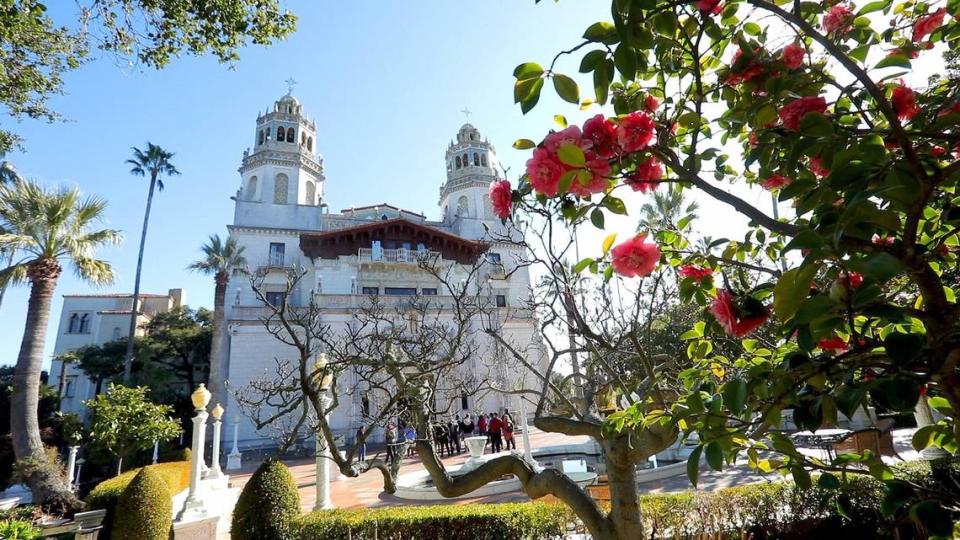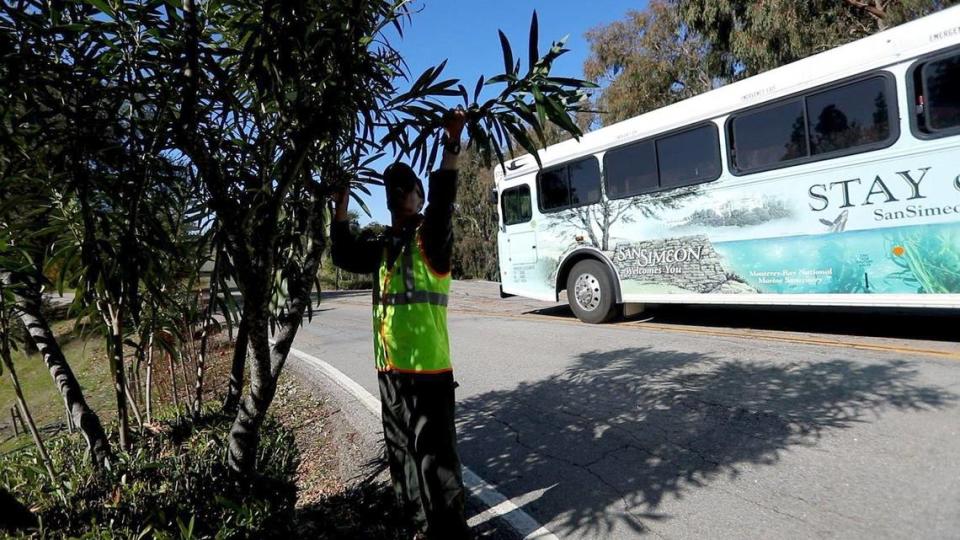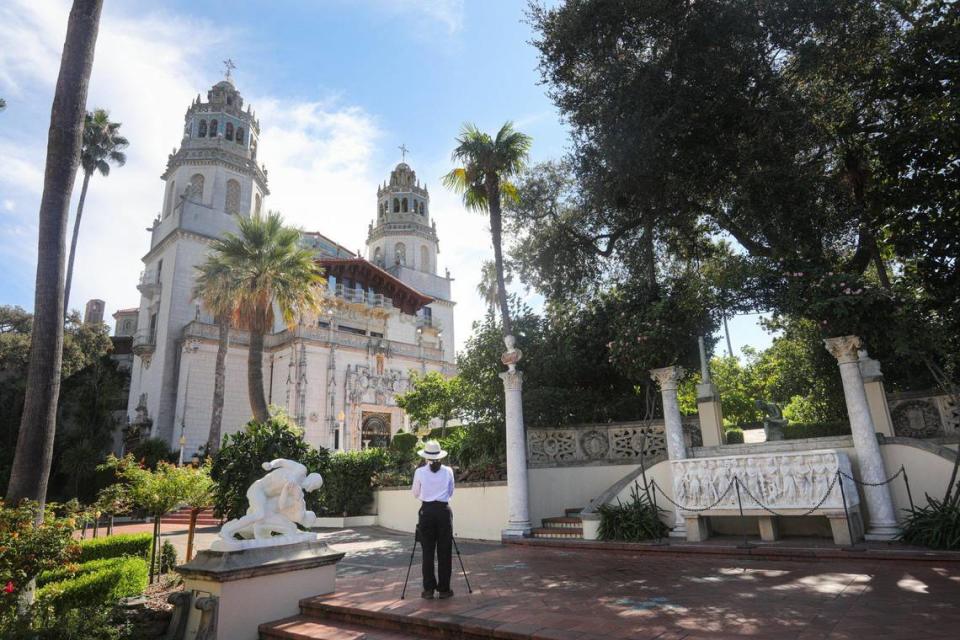When will Hearst Castle reopen? More road repairs are needed, officials say
As crews wrap up their initial road repair project at Hearst Castle, California State Park officials have discovered a new wrinkle.
They say additional repairs must be made to the upper 2.25 miles of the 5-mile access road that leads from the visitor center to William Randolph Hearst’s former hilltop estate in San Simeon.
Under a new emergency contract, estimated at $5.7 million, John Madonna Construction will completely redo the upper roadway.
According to Dan Falat, superintendent of the State Parks district that includes the Castle, the agency is still on target to meet its original estimate of reopening Hearst Castle sometime in the first quarter of 2022.

Hearst Castle access road gets culvert fixes
Hearst Castle has been closed to the public since March 2020, due to the COVID-19 pandemic and widespread storm damage to the steep, meandering road that leads to the former estate of media mogul William Randolph Hearst.
The roadway likely follows the path established by Hearst family members in the late 1800s and early 1900s as they traveled to their favorite camping site, dubbed “Camp Hill.”
When Hearst Castle construction began in about 1920, architect Julia Morgan likely converted the path into a hard-packed, gravel-topped road, putting in a culvert system to carry runoff away from the new surface, Falat said.
The paving didn’t happen until after Hearst’s death in 1951. His family donated his estate to the state in early 1958, and the first public tours were given that June.
Soon afterward, State Parks, Caltrans and Hearst Corp. worked together to pave the access road from Highway 1 to the Castle.
Tour buses normally take 22,000 trips a year up to the Castle and back. Falat estimated that each bus weighs between 20,000 and 33,000 pounds each, before people get aboard.
That pavement has been been patched many times since then, with the most extensive repairs having been done after big storms in 2017 — until now.
According to Falat, a $32,000 road analysis in late February showed 27 culverts under the top 2.25 miles of the roadway needed repairs or replacement.
The subterranean culverts run perpendicular to the roadway — mostly two separated lanes — with many of the drainages going under stonework, trees and the historic Hearst Pergola, an arbor-covered promenade through which Hearst and his guests used to walk and ride horses.
John Madonna Construction was awarded the nearly $8 million contract to remove and replace storm drain piping, as well as repair the pavement at those culverts.
The San Luis Obispo-based firm began work in late July, with a goal of wrapping up repairs by the end of 2021 or early 2022.
Then crews and consultants discovered potential problems in the spans of roadway between the culverts, Falat said.

More repairs needed for pavement
Decades of waterflows over and under the pavement, along with runoff from the top of the watershed, earthquakes, age and other factors also wreaked damage on the rest of the upper road to the point they could pose a health and safety hazard, Falat said.
Most of that damage was hidden.
Some portions of the road base under the asphalt were the roadway equivalent of Swiss cheese, and the pavement had fissures and cracks into which more rain and runoff could flow.
Falat said that water would continue to worsen the damage and up the ante for potential health and safety hazards for those traveling up the road.
When contractors dug out each culvert area, they discovered that the entire 2.25-mile stretch had degraded, Falat said. Then the extent and repairability had to be confirmed by sophisticated technology.
“Based on the analysis and information we have from consultants and geotechnical folks, these repairs need to be made,” he said. “It will be a full rehab of the entire (upper) road, not just the culvert sections.”
The present pavement is, quite simply, is “past its life cycle,” Falat said, noting that the asphalt has been there for more than a half century.
Rather than simply resurfacing the existing road with new asphalt, workers will put a new base and pavement on the entire 2.25-mile stretch.

Why start new fixes now?
Could the road repairs have been done concurrently? Falat says “no.”
Specific geotechnical and other studies were done first on the 27 specific culvert areas.
Once work on the that emergency contract began, engineers and other scientists expanded their search into emergency investigations into the condition of the rest of the upper section of road, from the cattle guard and the start of the Pergola to the gate into the Castle compound itself.
They suspected there might be other problems lurking under the pavement, Falat said, and they were right.
Once they “confirmed the structural inadequacies of the road” and determined that a patch job wouldn’t do it, “we knew we had to redo the road, and we might as well do it now,” he said. “Otherwise, the road’s condition would have continued to degrade,” and there would have been another closure in the not-too-distant future.
It’s taken this long to complete those studies and confirm the rest of road needed serious work, too.
The lower half of the Castle access road, from the midway point to the visitor center, also will be studied, Falat said, and he anticipates that section also will need substantial repairs or rebuilding. That project is currently funded, and being designed and engineered.
However, due to the somewhat flatter terrain and side-by-side traffic lanes, Falat said, “That project won’t be like this one. We won’t need to close. We can do one lane at a time, using traffic control, or doing work in the evenings or at odd hours.”
The good news, he said, is that barring heavy storms or an exceptionally rainy winter, the new road project’s completion date is expected to fall within the time allocated for the original culvert project — six to nine months from when construction began.
Like everybody else, Falat said, “We want the Castle to be open as soon as possible.”


